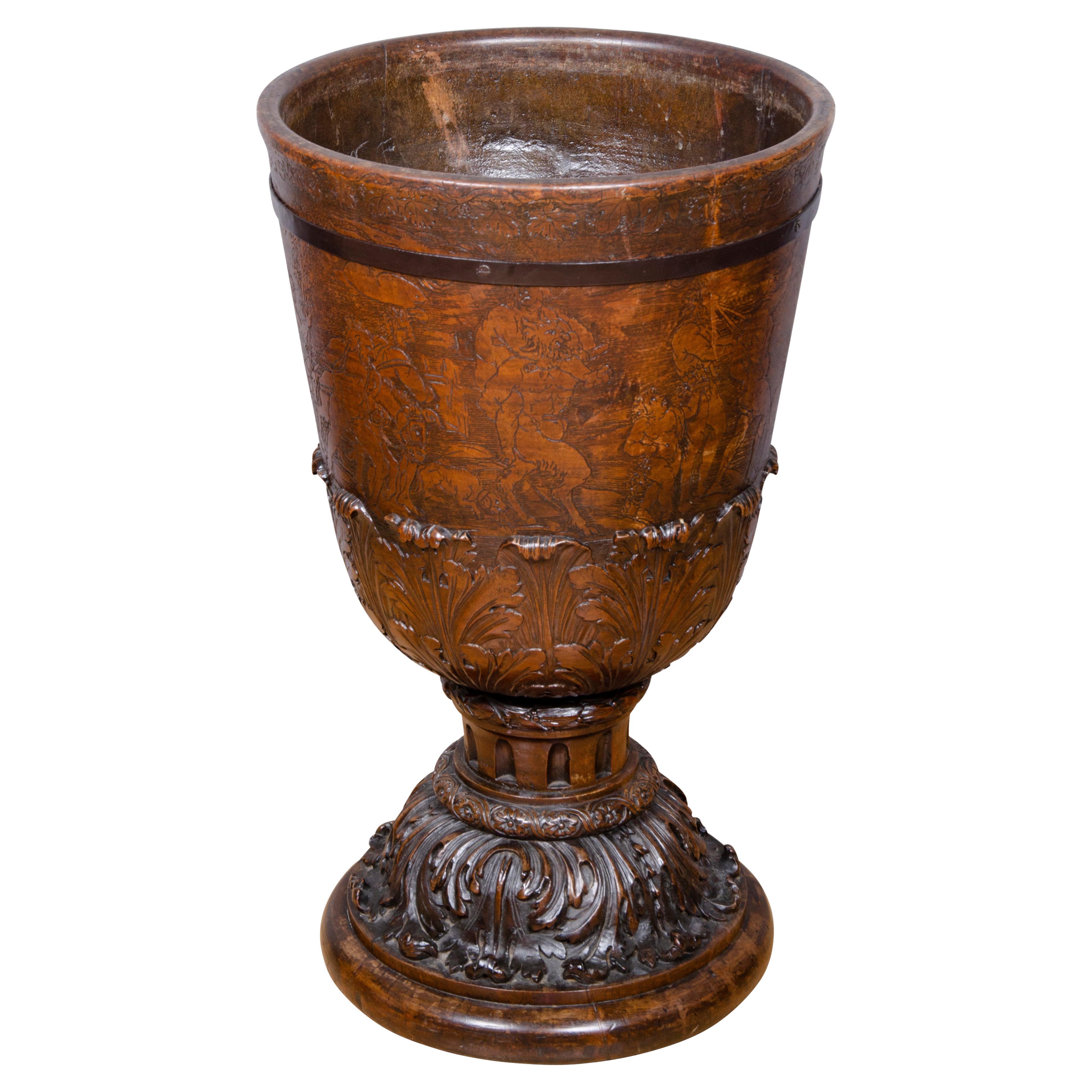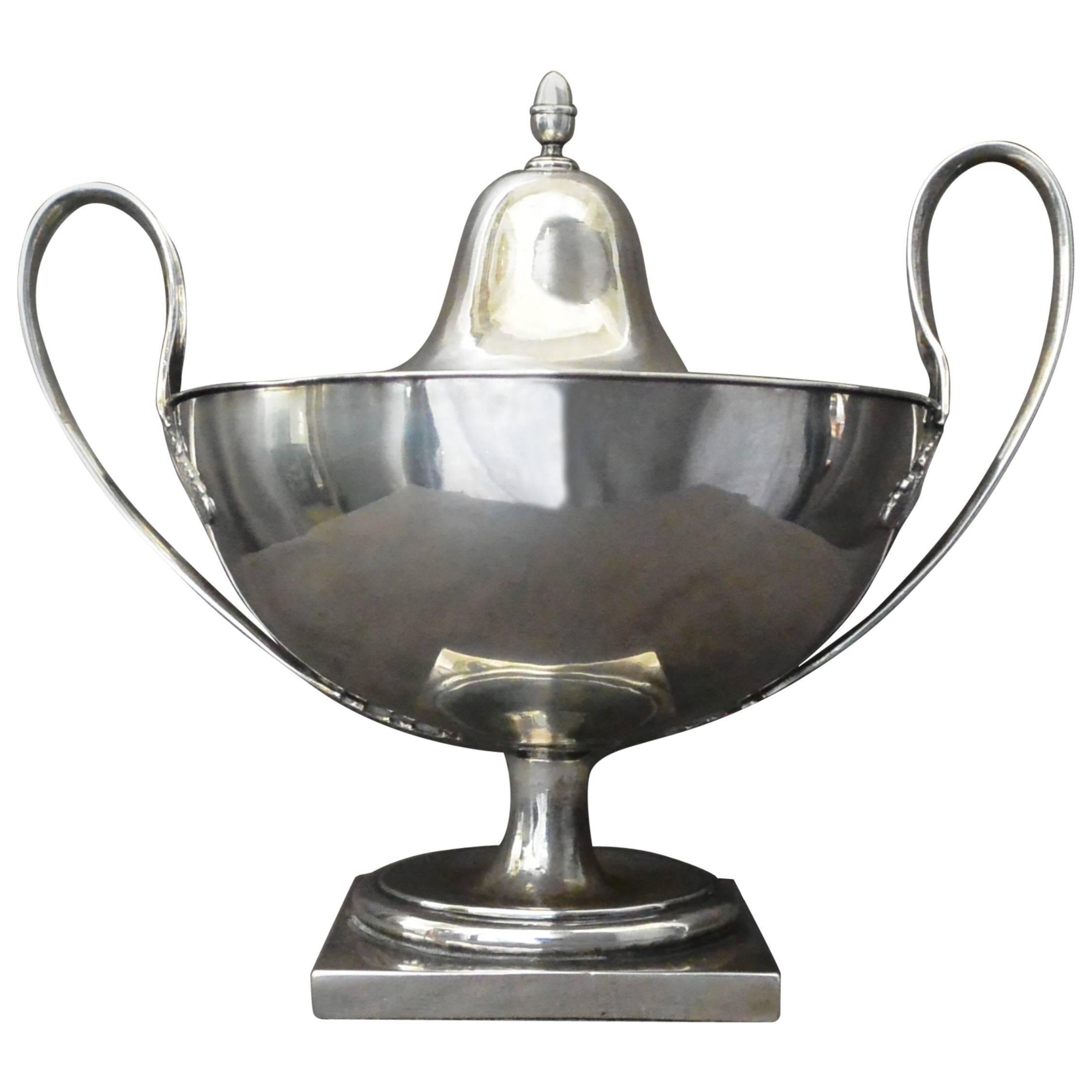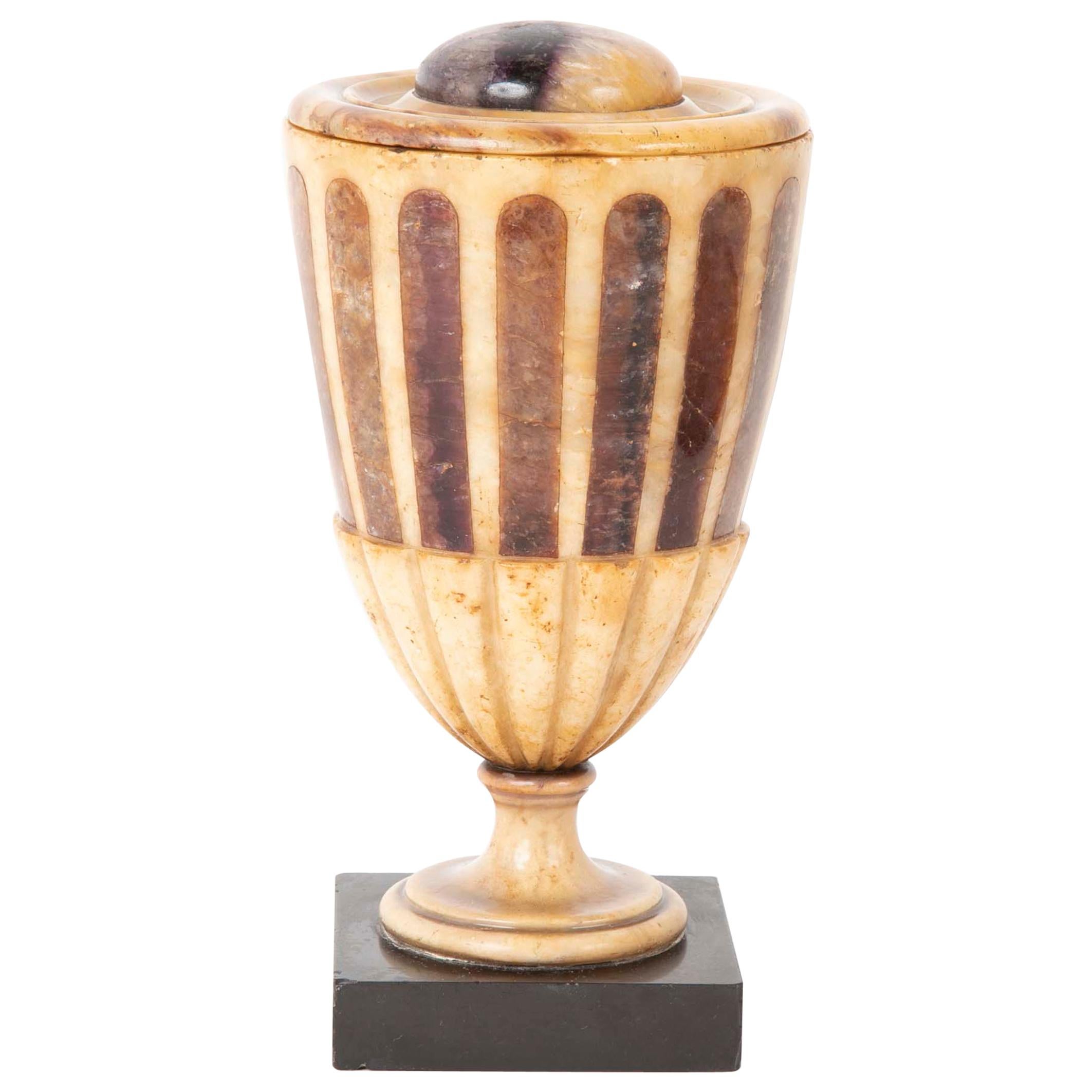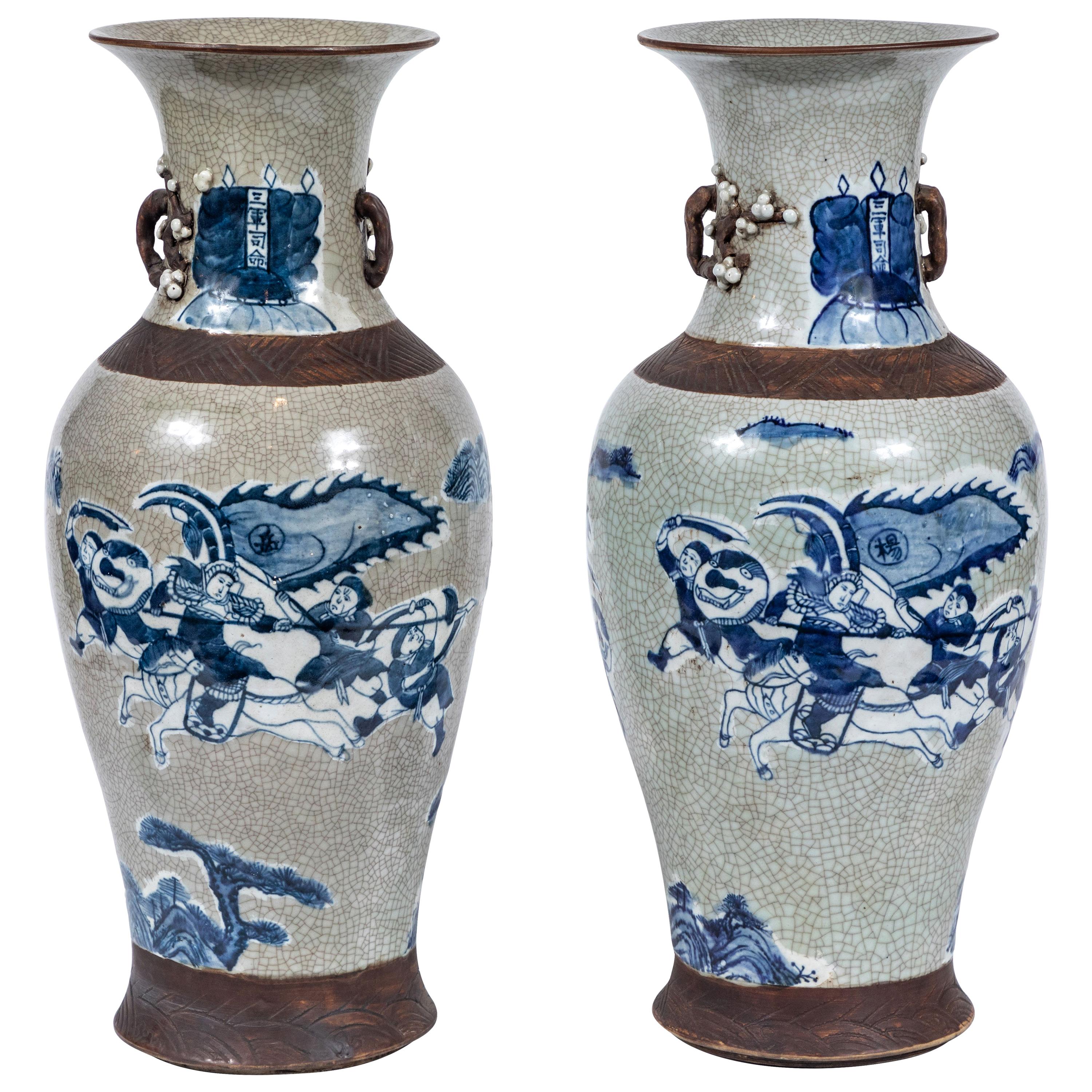Want more images or videos?
Request additional images or videos from the seller
1 of 5
Georgian Blue John and Silver Urn
About the Item
This important George III blue John urn is attributed to famed Swedish architect Sir William Chambers. The solid piece is carved entirely from rare Blue John Derbyshire spar, taken from the now-extinct Blue John Cavern in Derbyshire, England. Set atop its Ashford marble plinth, the form is mounted with elaborate silver ornament, including scrolling foliage and grotesque masks.
Blue John spar is a semi-precious mineral recognized by its beautiful radiating crystalline structure, which was only mined at a site near the village of Castleton in Derbyshire. Celebrated for its unique bands of blues, purples, and violets, Blue John was in great demand during the 18th and early 19th centuries. The colorful and decorative stone was even worked into columns in some of the finest houses in Great Britain, most notably Chatsworth, home of the Duchess of Devonshire. Due to its popularity, the largest veins of Blue John had disappeared by the early 19th century, and only a small amount of the stone remains. This rare Blue John urn, therefore, represents some of the last ornamental wares created of such grand size and proportion.
The architect and designer Sir William Chambers was born in Sweden and traveled widely throughout his life. Not only did he visit China, but also studied architecture both in Paris and in Italy. Many of his drawings from this period are contained in his important 'Franco-Italian' album, currently held in the Victoria & Albert Museum. Chambers moved to London in 1755 and published his influential Treatise on Civil Architecture in 1759. Although a highly trained court architect, Chambers boasted connoisseurship of furniture design including that of silver. Chambers was highly influenced by Continental Neoclassicism, and a second visit to Paris in 1774 confirmed the French influence on his own unique blend of Neoclassicism and Palladian conventions. Today, pieces by Chambers are highly sought after and can be found in important collections worldwide, including the Victoria & Albert Museum in London.
Measures: 12 1/2" high x 5 1/2" diameter.
- Creator:Sir William Chambers (Maker)
- Dimensions:Height: 12.5 in (31.75 cm)Diameter: 5.5 in (13.97 cm)
- Style:Neoclassical (In the Style Of)
- Materials and Techniques:
- Place of Origin:
- Period:
- Date of Manufacture:18th Century
- Condition:
- Seller Location:New Orleans, LA
- Reference Number:
About the Seller
5.0
Recognized Seller
These prestigious sellers are industry leaders and represent the highest echelon for item quality and design.
Established in 1912
1stDibs seller since 2010
93 sales on 1stDibs
Typical response time: 7 hours
- ShippingRetrieving quote...Ships From: New Orleans, LA
- Return PolicyThis item cannot be returned.
More From This SellerView All
- Blue John Closed UrnLocated in New Orleans, LAThis beautiful ornamental urn is carved of rare Blue John Derbyshire spar, taken from the now-extinct Blue John Cavern in Derbyshire, England. Crafted in a classically-inspired shape, this closed urn evokes the elegance of the Georgian period. Since the Roman era, Blue John was used to create fine decorative wares. This intriguing stone demands a great deal of skill in its handling and was the material most favored by silversmith Matthew Boulton, especially for the creation of his stoneware vases. A soft and brittle stone, it responds very quickly to heat, and must be carefully dried in order to retain its original color. This urn is wonderful example of Blue John artistry, circa 1810 Measures: 11 5/8" high Discovered by the Romans over 2,000 years ago, Blue John stone...Category
Antique 19th Century English Georgian Urns
MaterialsStone
- Pair Of Blue John And Bronze CassolettesLocated in New Orleans, LABlending natural wonder and artistic prowess, this magnificent pair of cassolettes is a symphony of craftsmanship. The intricate gilt bronze decor, only made possible by the finest c...Category
Antique Late 19th Century Jars
MaterialsStone, Bronze
- George III Marble and Blue John Dolphin TazzaBy Sir William ChambersLocated in New Orleans, LAThis important George III tazza is attributed to famed Scottish-Swedish architect Sir William Chambers. The magnificent piece features a base carved from statuary marble in the shape of a stylized dolphin, which relates to Chambers' extraordinary 18th-century architectural designs. A marvel of beauty and craftsmanship, the tazza is also inset with specimens of Derbyshire Blue John in both the plinth and bowl. Blue John is one of the most in-demand decorative stones in the world, and its inclusion in this piece elevates the tazza to a true Georgian masterpiece. Due to its popularity, the largest veins of Blue John had disappeared by the early 19th century, and only a small amount of the stone remains today. Because of its scarcity, most examples of Blue John furniture feature only small inset veneers. By contrast, this rare tazza features not one, but two substantial specimens of the stone. It represents some of the last ornamental wares created of such grand size and proportion, though other smaller examples still grace the stately British estates of Chatsworth, Hardwick, Kedleston and Haddon, among others. Not only does this tazza boast a highly rare material, but it was also designed by one of the most important architects and designers of the Georgian era. Sir William Chambers was a Scottish-Swedish architect based in London who was active during the reigns of Kings George II and George III. Celebrated for his combination of English Palladianism...Category
Antique 18th Century English George III Animal Sculptures
MaterialsStone, Marble
- Sèvres Palace Porcelain UrnsBy Manufacture Nationale de SèvresLocated in New Orleans, LAThese bronze-mounted Sèvres porcelain urns are monumental in both size and quality and feature the renowned manufactory’s signature deep cobalt blue glaz...Category
Antique 19th Century French Rococo Urns
MaterialsBronze, Ormolu
- Toledo Damascene Urn, Zamboanga StyleLocated in New Orleans, LAThis beautiful damascene urn is a wonderful example of Toledo metalwork. The incredibly fine oxidized steel with gold inlay is congruent with the organic motifs used by craftsmen in ...Category
Antique 19th Century Asian Urns
MaterialsGold, Steel
- Wedgwood Black Basalt Two-Handled UrnBy WedgwoodLocated in New Orleans, LAA remarkable example of Josiah Wedgwood's legendary ceramic art, the importance and rarity of this urn vase simply cannot be overstated. Black basalt refers to the fine-grained stoneware developed by Josiah Wedgwood in the 1760s that was inspired by the hard, natural stone known as Egyptian basalt...Category
Antique 19th Century English Urns
MaterialsCeramic, Stoneware
You May Also Like
- Pair of Blue John Fluorspar Decorative UrnsLocated in Stamford, CTPair of attractive blue John decorative urns, English 19th century, w. bulbous bodies in exquisite purple-blue and golden tones, with white marble finials and bases, standing on a bl...Category
Antique 1850s English Adam Style Urns
MaterialsMarble
- Large Georgian Mahogany Footed UrnLocated in Essex, MAShaped like a goblet. Tapered form carved and hollowed from a single piece of wood, the exterior decorated with a bacchanalian parade of figures of Pan playing instruments on and pul...Category
Antique 1760s English Georgian Urns
MaterialsMahogany
- Italian Silver Neoclassical Lidded UrnLocated in New York, NYItalian Silver Neoclassical Lidded Urn. Italian neoclassical sterling silver urn form zucchiera. Handles with foliate terminals and lid with a...Category
Antique Late 18th Century Italian Neoclassical Urns
MaterialsSterling Silver
- An English Alabaster Urn and Cover Inlaid with Blue John, circa 19th CenturyLocated in Stamford, CTAn alabaster urn and cover inlaid with blue John on square slate base. English, circa early 19th century.Category
Antique 1820s English Regency Urns
MaterialsMarble
- Unusual, Chinese, Gray-and-Blue UrnsLocated in Newport Beach, CAPair of beautifully made, hand painted, gray-ground, craqueleur-glazed urns featuring incised clay bands and sculpted, willow-branch armatures.Category
Vintage 1940s Chinese Vases
MaterialsClay, Porcelain
- Chinese White and Blue Character and Floral UrnLocated in New York, NYAntique Chinese (Late 19th Century) ceramic urn with blue floral designs surrounding bold, centered characters on 4 sides.Category
Antique 19th Century Chinese Chinese Export Urns
MaterialsPorcelain





